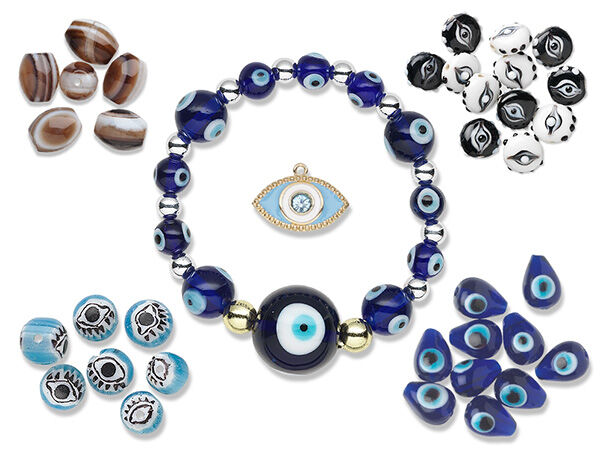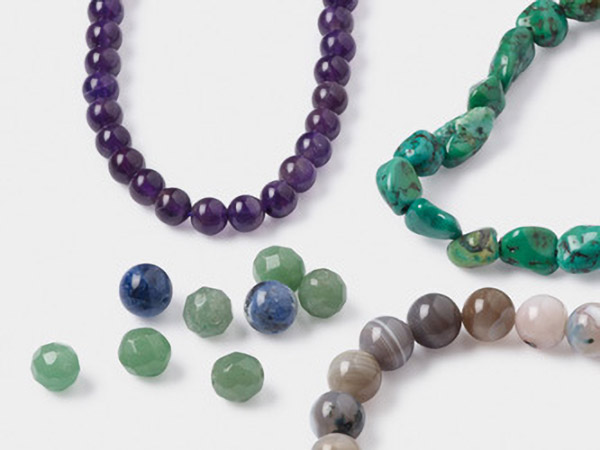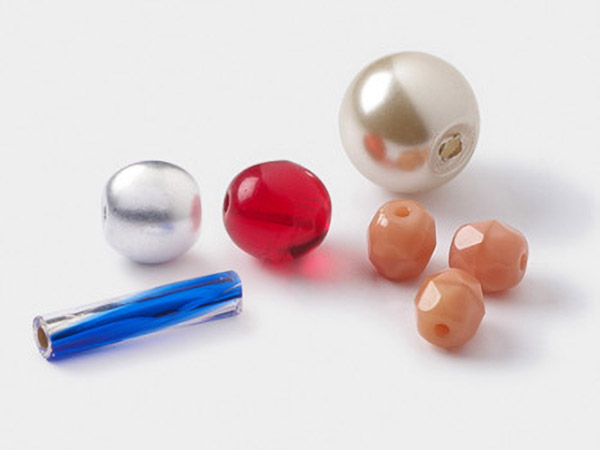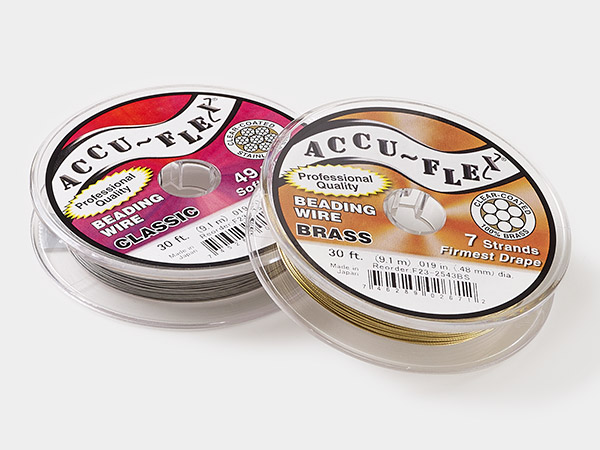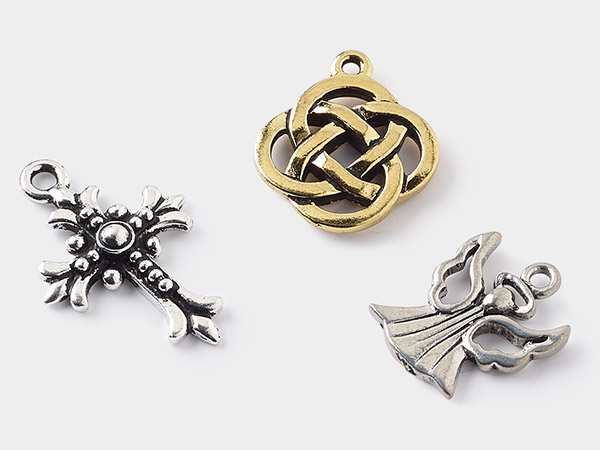Eye Beads of the World
For centuries, the belief in evil- eye protection has been an important part of many cultures. What is the story surrounding the popular eye symbol?
Throughout history, there has been a widely held conviction that eye contact with an envious neighbor, god or malevolent force can cause harm to people and their property, or afflict them with negative emotions such as jealousy and hatred.
It is commonly believed that no one, rich or poor, is safe from the wrathful stare of evil. To counter this, ancient civilizations created eye bead symbols and powerful talismans to wear for protection. The eye bead works under the philosophy of "an eye for an eye," canceling out negativity and evil with an ever-gazing eye bead staring right back, thus turning evil away.
It is believed that eye beads can bring peace of mind, ward off evil, expel bad luck and bring good fortune to the wearer. More recently, their meaning has expanded to include the cultivation of positive thoughts and happiness, too.
Eye Beads
There are many different variations of ICU, or "evil eye" beads. In Tibet and Mesopotamia, the mysterious etched agate gemstone eye beads are referred to as DZi (pronounced "zee" ) beads. In ancient Egypt, there is the eye of Horus known as the udjat (pronounced "ut-chat" ).
The flat, polished agate gemstone eye beads from Western Asia and the Middle East resemble the gentle eyes of goats and camels. In parts of Africa and Sudan, the cowrie shell bead is believed to represent the human eye and is valued as protection against evil. India produces the fabulously ornate paisley-like Minikari beads. On the other side of the world, the Native tribes of the Pacific Northwest Coast created a remarkable style of an ovoid-like eye symbol that is commonly found in their artwork.
As glass has become readily available, it has been used to make protective glass eye beads. Blue Moroccan, Turkish and Greek eye beads are still seen in modern-day Mediterranean and Middle Eastern homes. The Warring States era of China brought the famous glass horned-eye beads with their horn-like bumps made of colorful concentric layers of bull's-eye dots. Even gemstone beads, such as tigereye and red coral, have been valued for averting the evil eye.
Tibetan DZi Beads
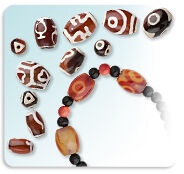
The mystery surrounding the Tibetan DZi beads stems from their puzzling origin more than a millennium ago. The DZi bead is an oblong barrel, cylinder or tubular bead with eye symbols, zigzags and wave patterns covering its surface. DZi beads are usually made from agate because this stone is believed to ward off evil. To Tibetans and other Himalayan peoples, the DZi is a precious jewel of supernatural origin with great power to protect its wearer from disaster. Admirers of DZi beads wear them to repel evil, foster good health and bring wealth.
Stories of Tibetan DZi beads' origin have been passed down orally over the centuries. These range from legends of cast- off beads from benevolent deities to mysteriously petrified holy insects or treasure taken as spoils of victory from a conquered Persian king. Due to the shy and reclusive nature of Tibetan legends, scholars have been unable to verify the true origin of DZi beads, so their roots remain cloaked in mystery.
Each variation of eye patterns in the DZi beads has a specific meaning. Nine eyes together are said to help the wearer avoid calamities and injuries, ensure safety in human life and bring blessings and wealth. The two-eyed DZi bead promotes a protected marriage of harmony and improves wisdom. The most common patterns on DZi beads are two to nine eyes, with nine eyes being the most desired.
Flawless varieties of ancient DZI beads, called "pure" DZi beads, are extremely rare, outrageously expensive and avidly sought by museums and DZi bead collectors. Modern reproductions of etched agate DZi beads, known as Chung Dzi beads , are a great way to obtain the look of traditional-style DZi eye beads at a fraction of the cost.
Agate Eye Beads
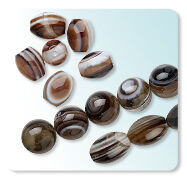
Middle Eastern and Asian agate eye beads are made of striped onyx, sardonyx and banded agate that is cut and polished to produce an unblinking eye of superb quality. Such agate gemstone eye beads have been found in the ancient graves of Sumerian royalty, indicating they were used for protection in the afterlife.
Stratified agate eye beads are still used widely to adorn everything for protection from wandering evil. In ancient Middle Eastern tradition, an agate eye bead would be exchanged at the close of a business deal between parties for luck and prosperous business. This tradition is still practiced at the completion of modern- day business transactions Middle East.
Minikari, Mirrors and Cowrie Shells
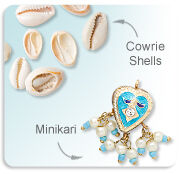
Minikari components, mirrors and cowrie shells are extremely popular in Eastern Indian jewelry and clothing to deflect jealous evil eyes. The "mirroring back" of the evil eye in ornate multicolored jewelry and clothing covered with mirrors reflects the evil gaze back to the sender. Cowrie shells, found in the coastal waters of the Indian and Pacific oceans, are regarded as a protective amulet by Rajasthani women of the Banjara tribes. At one time, the cowrie shell was so valuable to the people of Africa that it was even used as currency. Cowrie shells, like mirrors, are also sewn into clothing and jewelry for protection.
Minikari components are another distinctive style originating in 16th century India. Made using sterling silver formed over wax, they are known for exquisite detailing and ornate paisley-like beauty. The components are colored with Meena enameled colors in red, green, black, yellow and blue. They are used to make jewelry for the feet, hands, ears, neck, waist and face to protect actions and thoughts.
The most popular Minikari component shapes used in eye design jewelry are almonds, rounds, paisleys and hearts in bright, joyful colors. Sometimes, the Minikari component will have a red dot on a blue background or concentric rings with a center dot symbolizing a beautiful eye capable of chasing away evil.
Glass Eye Beads
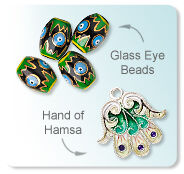
Turkish glass eye beads, the most common eye bead used to repel envy and other negative thoughts, is known by the proper name Nazar Boncuk. Glass eye beads are generally blue in color because cobalt and turquoise blues are thought to be the most defensive colors against evil. Not only are the vibrant blue eyes of Turkey and neighboring countries said to protect the wearer from ill, but they are currently being used to encourage positive thinking--in a way protecting you from your own negativity!
This is perhaps the main reason why Turkish glass eye beads are so popular all over the world. It is common to see blue eye beads on babies, horses, doors, windows, cars and cell phones. There are even large versions of painted blue eyes on Turkish jet planes.
Even though beautiful, blue eye beads are seen alone in jewelry, they are also seen paired with the hand of Hamsa, also known as the hand of Fatima and Miriam. The Hamsa hand is a hand with two thumbs and three fingers pointing downwards. With blue glass eye beads made of striking cobalt blue, vivid reds, lemon yellows or pure white glass with black center dots strung on red cord, evil thoughts are believed to quickly evaporate before their purposeful stare.
Horned Glass Beads
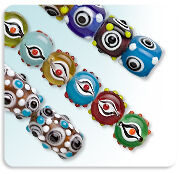
Some of the most technically complex glass beads ever created were made during the Warring States era of China from 481- 221 B.C. The heavy beads had marvelously detailed layers of glass dots in geometric patterns to create protruding bumpy glass eye beads. Horned glass beads were popular to place on objects used on a daily basis. They were frequently hidden within the folds of clothing and bedding, tied to teapots and hung on the branches of fruit orchard trees.
The ancient variety of bumpy glass eye beads is scarce and almost impossible to find. You can own a modern version of bumpy glass eye beads made in the same style with bright, cheerful colors.
Ovoid Eyes
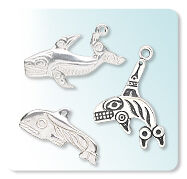
The eye symbol is used in a remarkable way in traditional Native American culture. It is richly embedded into their artwork in the form of intricate wooden carvings and brightly colored paintings on totems, masks, blankets and hats.
A few of the Pacific Northwest tribes, such as the Haida and Tlingit, have perfected the art form that is singularly recognizable around the world. Looking into the ovoid-shaped eyes of one of these Pacific Northwestern tribal creatures is like peering deeply into the very soul of nature itself. The meaning behind these eyes is to achieve harmony and a closer connection with nature, and to bring good luck and protection from evil and mischief.
Red Coral and Tigereye Beads
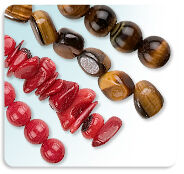
From the 1830s to the 1920s, European and North American children's jewelry, baby rattles and teething rings were made with fine red coral beads because red coral was believed to ward off evil and promote good health. Most children during the pioneer days of North America (1835-1850) had a single-strand necklace of dainty red coral beads to keep them safe from the ravages of childhood illness. Women avidly collected and wore entire jewelry parures of red coral. The most common protective jewelry for pregnant and nursing mothers was a branch of red coral worn as a lone pendant.
The wearing of tigereye gemstone jewelry was, and still is, popular to protect its wearer from misfortune. Because of the chatoyant quality of tigereye, it is believed that tigereye gemstone beads are capable of spotting evil from all directions at once.
The "Eyes" Have It
The fascinating history of eye beads reminds us that gemstone and glass beads have always been more than adornment. The meaning and beliefs surrounding eye beads demonstrate the deep and thoughtful ideas of humankind. The stories and meanings of eye beads are wonderful to share with friends, family and customers. Worn and carried for over five-thousand years, the eye beads of the world have reached across time to create a unanimous human reaction to protect and preserve life.
Shop for Your Materials Here:
Have a question regarding this project? Email Customer Service.
Copyright Permissions
All works of authorship (articles, videos, tutorials and other creative works) are from the Fire Mountain Gems and Beads® Collection, and permission to copy is granted for non-commercial educational purposes only. All other reproduction requires written permission. For more information, please email copyrightpermission@firemtn.com.
**Please note that all metaphysical or healing properties listed are collected from various sources. This information is offered as a service and not meant to treat medical conditions. Fire Mountain Gems and Beads® does not guarantee the validity of any of these statements.
